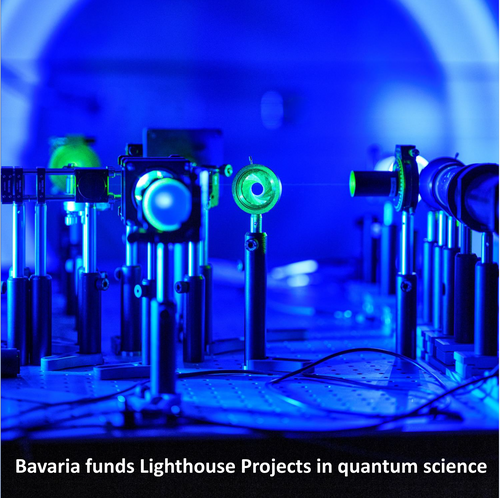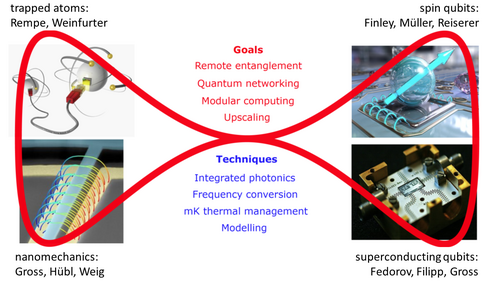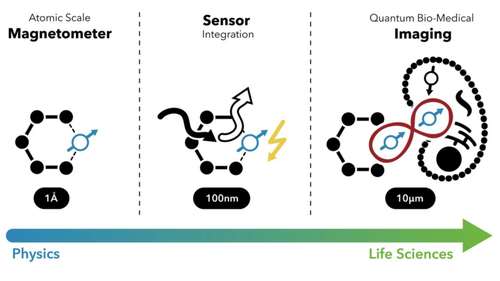WMI gets funding for MQV Lighthouse Projects
04 August 2022
Bavaria launches "Lighthouse Projects" to promote basic research in QST
Basic research projects in quantum science and technology (QST) are essential to keep Bavaria's leading role in this field. Therefore, the Free State of Bavaria provides funding for five interdisciplinary "Lighthouse Projects" with a total budget of about 17 million euros as part of the Munich Quantum Valley e.V. (MQV). The projects will start in January 2023.
The Lighthouse Projects involve the universities in Erlangen-Nuremberg, Munich, Passau, Regensburg and Würzburg. Moreover, the OTH Regensburg and the Deggendorf Institute of Technology were successful with their proposals. Among the non-university institutions, the Walter-Meißner-Institute of the Bavarian Academy of Sciences and Humanities, the Max-Planck Institute of Quantum Optics and the Fraunhofer Institute for Integrated Circuits contribute to the research projects.
Promotion of quantum sciences throughout Bavaria
Science Minister Markus Blume strongly supports the promotion of QST throughout Bavaria by the Lighthouse Projects: "We want to provide targeted support for interdisciplinary and cross-university projects that can lay the foundations for groundbreaking innovations. Innovations that we can't even imagine today. And which will have a positive impact on us and on future generations. Thus, the future-oriented topic of quantum technologies demonstrates the great visionary quality of the Hightech Agenda of our Minister President Dr. Markus Söder. With Munich Quantum Valley as its epicenter, the Free State is an internationally recognized top location for quantum technologies."
The Lighthous Projects are a particular measures within the Hightech Agenda Bavaria, aiming to support Bavaria's universities in bringing innovations into practical applications. Bavaria is investing around 300 million euros into quantum sciences and technologies. At the heart of this effort is the Munich Quantum Valley e.V., an alliance of the Bavarian Academy of Sciences and Humanities (BAdW), the Fraunhofer Society (FhG), the Friedrich-Alexander University Erlangen-Nuremberg (FAU), the German Aerospace Center (DLR), the Ludwig-Maximilians-Universität München (LMU), the Max Planck Society (MPG) and the Technical University of Munich (TUM).
WMI contributes to two ambitious Lighthouse Projects
The WMI is a key partner in two of the Lighthouse Projects. "We are very happy that WMI can contribute to the ambitious Lighthouse Projects Networked Quantum Systems (NeQuS) and Integrated Spin Systems for Quantum Sensors (IQ-Sense), aiming at the development of integrated quantum sensors for imaging applications in tissue analysis or the hardware for network nodes in hybrid quantum systems", WMI director Rudolf Gross says, who was strongly supporting the idea of basic research oriented Lighthouse Projects in the application phase of MQV. "I am sure that the Lighthouse Projects will boost Bavarian-wide collaborations and trigger many innovations", he adds.
I. Networked Quantum Systems (NeQuS)
In quantum technologies, presently no hardware platform fulfills all requirements for useful applications. Thus, hybrid systems that fortuitously combine the advantageous properties of different quantum systems, while circumventing their disadvantageous characteristics, are extremely powerful. The NeQuS project aims to establish such hybrid quantum systems, in which nodes located in different research institutes are linked together using quantum interfaces. The nodes will be based on different hardware platforms including all major systems investigated in quantum technology: superconducting circuits, trapped atoms, nanomechanical resonators, and spins in solids. The project aims at interfacing all of these platforms via quantum states of light propagating in room-temperature optical fibers.
The key challenge in this context is that the individual platforms operate at very different energy scales. While superconducting quantum circuits and nanoelectromechanical systems use microwave photons with characteristic energies in the range of 10-6 -10-5 eV, neutral atoms and spins in solids emit visible or infrared photons with an energy around 1 eV - each at a different frequency. To be able to connect these different systems, each of them will establish an interface to photons at telecommunication wavelength. Such photons in the minimal loss regime of optical fibers are ideal carriers of quantum information over many kilometers at ambient temperature, which will lay the ground to distribute entanglement between the different platforms in NeQuS.
Building on established photonic technologies and protocols for quantum state distribution, the central goals of NeQuS are:
- To implement hybrid quantum transducers that allow each platform to generate or receive photons at a telecommunication wavelength
- To develop performant quantum interconnects between the different platforms
- To establish entanglement between the individual systems
- To build quantum network demonstrators and develop protocols for their up-scaling
With these key capabilities, the envisioned hybrid systems will gain access to the full functionality and strengths of each of the involved hardware platforms.
Consortium:
- Walther-Meißer-Institute (BAdW/TUM): K. Fedorov, S. Filipp, R. Gross, H. Hübl
- Technical University of Munich (TUM): J. Finley, K. Müller, A. Reiserer, E. Weig
- Ludwig-Maximilians Universität (LMU): H. Weinfurter
- Max Planck Institute of Quantum Optics (MPQ): G. Rempe
II. Integrated Spin Systems for Quantum Sensors (IQ-Sense)
The precise measurement of physical quantities transcends all of the natural and engineering sciences, as well as life sciences and medicine. In the quest to achieve higher precision, and open the doors towards the development of radically new technologies, sensors are now reaching the quantum limit for which the “sensing element” is a discrete quantum system that interacts with its environment.
The central goal of the Lighthouse Project IQSense is to synergistically link leading groups from natural science (physics, chemistry), engineering (electrical engineering, information sciences) with researchers working in life sciences and medicine. Thereby, IQ-Sense will develop and demonstrate integrated quantum sensors for a range of application scenarios, including fast screening methods for biological matter. The project IQSense joins leading Bavarian groups working in materials science and quantum sensing technologies and brings them together with clinicians working on the development of cutting edge imaging and sensing technologies.
Consortium:
- Julius-Maximilians-Universität Würzburg (JMUW): V. Dyakonov, B. Hecht, K. Heinze, S. Höfling, M. Sauer
- Walther-Meißer-Institute (BAdW/TUM): R. Gross, H. Hübl
- Technical University of Munich (TUM): Ch. Back, M. Brandt, D. Bucher, J. Finley, F. Schilling, G. Westmeyer
More Information:
Contact:
Prof. Dr. Rudolf Gross
Walther-Meißner-Institute
Bavarian Academy of Sciences and Humanities and Technical University of Munich
Walther-Meißner-Str. 8
85748 Garching, Germany
Email: Rudolf.Gross[at]wmi.badw.de
Prof. Dr. Stefan Filipp
Walther-Meißner-Institute
Bavarian Academy of Sciences and Humanities and Technical University of Munich
Walther-Meißner-Str. 8
85748 Garching, Germany
Email: Stefan.Filipp[at]wmi.badw.de



